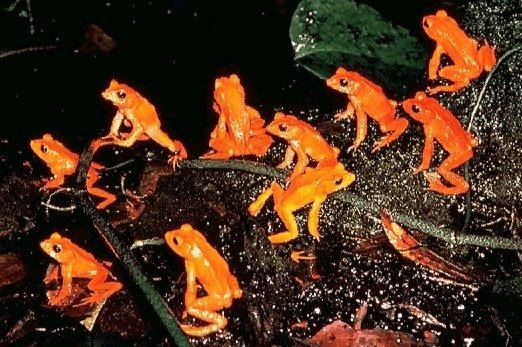Disease wiping out amphibians before they can be identified
By Michael McCarthy, Environment Editor
Tuesday, 20 July 2010 The frog-killing disease which is sweeping parts of the world is now wiping out amphibian species before they have even been described, new research has shown. Dramatic declines in amphibian populations in the Americas and Australia have been known since the late 1980s, exemplified by the disappearance of the famous golden toad of the cloud forests of Costa Rica, which has not been seen since 1989. At first the declines were a mystery, but 10 years ago it was realised that many of the disappearing frog, toad and salamander populations were being killed off by a fungal disease called chytridiomycosis. It was thought that global warming might be helping the disease to establish itself. Now a before-and-after monitoring programme established in Costa Rica’s neighbouring state of Panama has shown just how devastating the fungal affliction is when it sweeps through amphibian communities. American scientists working at Panama’s Omar Torrijos National Park in El Copé did a detailed survey of all the frogs present between 1998 and 2003, before chytridiomycosis arrived, and identified 63 species. The disease then swept through the area, and when a repeat survey was done between 2006 and 2008, no fewer than 25 species had disappeared, according to a study published today in the Proceedings of the National Academy of Science. But there was more bad news, as researchers used a more precise technique known as DNA barcoding to establish that among the frogs which had previously been catalogued, there were more species than they thought – in fact there were an extra 11 unnamed or “candidate” species. And of these 11, another five had been wiped out by the fungus, giving a total of 30 species lost, before they had even been properly described by science. “It’s sadly ironic that we are discovering new species nearly as fast as we are losing them,” said Andrew Crawford, formerly of the Smithsonian Tropical Research Institute and now at the University of the Andes in Colombia. “Our DNA barcode data reveal new species even at this relatively well-studied site, yet the field sampling shows that many of these species new to science are already gone here.” Professor Karen Lips of the University of Maryland, who did the original survey of the frogs on the site, said that the areas where the disease had passed through were “like graveyards”. She said: “There’s a void to be filled and we don’t know what will happen next.” Biologists are increasingly alarmed at the numbers of species disappearing. It is thought that more than 120 may have become extinct since 1980 and the Global Amphibian Assessment lists more than 400 as critically endangered. “If a disease were wiping out species of mammals at this rate, people would be freaking out,” the Smithsonian Institute’s Beth King said yesterday. “Just imagine if it was whales and rabbits.” It is now thought that between a third and half of the world’s 6,000 amphibian species could be wiped out in the coming decades by the disease’s chytrid fungus, which kills by attacking the skin of frogs, through which they breathe. Warmer temperatures likely to have been caused by climate change appear to make its effects worse.
